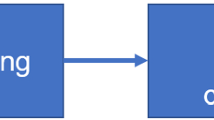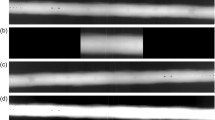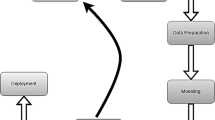Abstract
This study presents a Decision Support System (DSS) designed for Non-Destructive Online Evaluation in welding. Based on the Multi-Scale Dense Cross Block Network (MDCBNet), it is able to detect, classify, and recommend remedial actions to prevent surface defects in welding. The performance of the network architecture is enhanced with synthetic defect samples generated through image augmentation techniques. By employing gradient attribution and t-SNE plot methods, we gained insights into the network’s predictions and comprehensively analyzed decision-making process. Comparative evaluations against pre-trained deep learning techniques revealed that our proposed model exhibits significant improvements, ranging from 2 to 10% across various performance metrics. Extensive comparisons with state-of-the-art methods underscored the effectiveness of our approach in detecting and classifying weld defects. Notably, our network, initially trained on Gas Tungsten Arc Welding images, demonstrated remarkable adaptability and versatility by effectively classifying images from Gas Metal Arc Welding processes. These findings emphasize the potential of the MDCBNet-based DSS to enhance welding practices, thereby contributing to producing high-quality weldments. The successful implementation of our DSS recommendations further supports its capacity to optimize the welding process and facilitate improved weld quality.















Similar content being viewed by others
Data Availability
The datasets generated and analyzed during the current study are available from the corresponding author upon reasonable request.
References
Haghshenas, M., Gerlich, A.P.: Joining of automotive sheet materials by friction-based welding methods: a review. Eng. Sci. Technol. An. Int. J. 21(1), 130–148 (2018). https://doi.org/10.1016/j.jestch.2018.02.008
Sadeghian, A., Iqbal, N.: A review on dissimilar laser welding of steel-copper, steel-aluminum, aluminum-copper, and steel-nickel for electric vehicle battery manufacturing. Opt. Laser Technol. 146, 107595 (2022). https://doi.org/10.1016/j.optlastec.2021.107595
Sharma, P., et al.: Recent developments in the design, development, and analysis of the influence of external magnetic-field on gas-metal arc welding of non-ferrous alloys: review on optimization of arc-structure to enhance the morphology, and mechanical properties of welded. Heliyon 8(12), e11812 (2022). https://doi.org/10.1016/j.heliyon.2022.e11812
Bacioiu, D., Melton, G., Papaelias, M., Shaw, R.: Automated defect classification of aluminium 5083 TIG welding using HDR camera and neural networks. J. Manuf. Process 45(August), 603–613 (2019). https://doi.org/10.1016/j.jmapro.2019.07.020
Jolly, M.R., et al.: Review of non-destructive testing (NDT) techniques and their applicability to Thick Walled composites. Procedia CIRP. 38, 129–136 (2015). https://doi.org/10.1016/j.procir.2015.07.043
Mery, D., Pieringer, C.: Computer vision for x-ray testing: imaging, systems, image databases, and algorithms. Springer, Cham (2021). https://doi.org/10.1007/978-3-030-56769-9
Amarnath, M., Sudharshan, N., Srinivas, P.: Automatic detection of defects in welding using deep learning - a systematic review. Mater. Today Proc. (2023). https://doi.org/10.1016/j.matpr.2023.03.268
Liu, T., Zheng, P., Bao, J.: Deep learning-based welding image recognition: a comprehensive review. J. Manuf. Syst. 68(May), 601–625 (2023). https://doi.org/10.1016/j.jmsy.2023.05.026
Valdiande, J.J., Martínez-Minchero, M., Cobo, A., Lopez-Higuera, J.M., Mirapeix, J.: On-line monitoring and defect detection of arc-welding via plasma optical spectroscopy and LIBS. Spectrochim. Acta Part B Spectrosc. 194, 106474 (2022). https://doi.org/10.1016/j.sab.2022.106474
Mordia, R., Kumar Verma, A.: Visual techniques for defects detection in steel products: a comparative study. Eng. Fail Anal. 134, 106047 (2022). https://doi.org/10.1016/j.engfailanal.2022.106047
Patil, R.V., Reddy, Y.P.: An autonomous technique for multi class weld imperfections detection and classification by support vector machine. J. Nondestruct. Eval. 40(3), 76 (2021). https://doi.org/10.1007/s10921-021-00801-w
Mery, D.: Automated detection of welding defects without segmentation. Mater. Eval. 4860(143), 657–663 (2011)
Ajmi, C., Zapata, J., Martínez-Álvarez, J.J., Doménech, G., Ruiz, R.: Using deep learning for defect classification on a small weld x-ray image dataset. J. Nondestruct. Eval. 39(3), 68 (2020). https://doi.org/10.1007/s10921-020-00719-9
Gantala, T., Balasubramaniam, K.: Automated defect recognition for welds using simulation assisted TFM imaging with artificial intelligence. J. Nondestruct. Eval. 40(1), 28 (2021). https://doi.org/10.1007/s10921-021-00761-1
Yang, L., Fan, J., Huo, B., Liu, Y.: Inspection of welding defect based on multi-feature fusion and a convolutional network. J. Nondestruct. Eval. 40(4), 90 (2021). https://doi.org/10.1007/s10921-021-00823-4
Zapata, J., Vilar, R., Ruiz, R.: Automatic inspection system of welding radiographic images based on ANN under a regularisation process. J. Nondestruct. Eval. 31(1), 34–45 (2012). https://doi.org/10.1007/s10921-011-0118-4
Hou, W., Wei, Y., Jin, Y., Zhu, C.: Deep features based on a DCNN model for classifying imbalanced weld flaw types. Meas. J. Int. Meas. Confed. 131, 482–489 (2019). https://doi.org/10.1016/j.measurement.2018.09.011
Bacioiu, D., Melton, G., Papaelias, M., Shaw, R.: Automated defect classification of SS304 TIG welding process using visible spectrum camera and machine learning. NDT E Int. (2019). https://doi.org/10.1016/j.ndteint.2019.102139
Guo, R., Liu, H., Xie, G., Zhang, Y.: Weld defect detection from Imbalanced radiographic images based on contrast enhancement conditional generative adversarial network and transfer learning. IEEE Sens. J. 21(9), 10844–10853 (2021). https://doi.org/10.1109/JSEN.2021.3059860
Malarvel, M., Singh, H.: An autonomous technique for weld defects detection and classification using multi-class support vector machine in X-radiography image. Optik (Stuttg) 231, 166342 (2021). https://doi.org/10.1016/j.ijleo.2021.166342
Tyystjärvi, T., Virkkunen, I., Fridolf, P., Rosell, A., Barsoum, Z.: Automated defect detection in digital radiography of aerospace welds using deep learning. Weld. World 66(4), 643–671 (2022). https://doi.org/10.1007/s40194-022-01257-w
W. Luo, Y. Li, R. Urtasun, and R. S. Zemel.: Understanding the Effective Receptive Field in Deep Convolutional Neural Networks. CoRR, http://arxiv.org/abs/1701.04128 2017
Sonwane, S., Chiddarwar, S., Rahul, M.R., Dalvi, M.: Pre-trained CNN Based SVM classifier for weld joint type recognition. The future technologies conference (FTC) Volume 1, 2023, pp. 185–197. https://doi.org/10.1007/978-3-031-18461-1_12#citeas (2022)
Siores, E.: Expert systems - an application to welding adaptive control. IFAC Proc. 25(28), 93–96 (1992). https://doi.org/10.1016/s1474-6670(17)49471-7
Hinton, G., Roweis, S.: Stochastic neighbor embedding. Adv. Neural Inf. Process Syst. (2003). https://doi.org/10.1007/978-3-031-10602-6_16
Acikgoz, H., Korkmaz, D.: MSRConvNet: classification of railway track defects using multi-scale residual convolutional neural network. Eng. Appl. Artif. Intell. (2022). https://doi.org/10.1016/j.engappai.2023.105965
Xu, P., Guo, Z., Liang, L., Xu, X.: Multi-scale feature learning network for classification of surface defects of multifarious sizes. Sensors (2021). https://doi.org/10.3390/s21155125
Li, J., Fang, F., Li, J., Mei, K., Zhang, G.: Multi-scale dense cross network for image super-resolution. IEEE Trans. Circuits Syst. Video Technol. 31(7), 2547–2561 (2021). https://doi.org/10.1109/TCSVT.2020.3027732
Li, J., Fang, F., Mei, K., Zhang, G.: Multi-scale residual network for image super-resolution. Computer vision-ECCV 2018, pp. 527–542 (2018)
Rafiq, H., Shi, X., Zhang, H., Li, H., Ochani, M.K., Shah, A.A.: Generalizability improvement of deep learning-based non-intrusive load monitoring system using data augmentation. IEEE Trans. Smart Grid 12(4), 3265–3277 (2021). https://doi.org/10.1109/TSG.2021.3082622
Investigate Classification Decisions Using Gradient Attribution Techniques.: MATLAB & Simulink-MathWorks India, https://in.mathworks.com/help/deeplearning/ug/investigate-classification-decisions-using-gradient-attribution-techniques.html Accessed 29 May 2023
M. T. Ribeiro, S. Singh, and C. Guestrin.: Why should i trust you?’: Explaining the predictions of any classifier. In: Proceedings of the 22nd ACM SIGKDD International Conference on Knowledge Discovery and Data Mining, pp. 1135–1144. https://doi.org/10.1145/2939672.2939778 (2016)
Shafi, I., Mazahir, A., Fatima, A., Ashraf, I.: Internal defects detection and classification in hollow cylindrical surfaces using single shot detection and MobileNet. Meas. J. Int. Meas. Confed. 202, 111836 (2022). https://doi.org/10.1016/j.measurement.2022.111836
Wang, X., Zhang, Y., Liu, J., Luo, Z., Zielinska, T., Ge, W.: Online detection of weld surface defects based on improved incremental learning approach. Expert Syst. Appl. 195(391), 116407 (2022). https://doi.org/10.1016/j.eswa.2021.116407
Dong, X., Taylor, C.J., Cootes, T.F.: Automatic aerospace weld inspection using unsupervised local deep feature learning. Knowl. Based Syst. 221, 106892 (2021). https://doi.org/10.1016/j.knosys.2021.106892
Xia, C., Pan, Z., Fei, Z., Zhang, S., Li, H.: Vision based defects detection for keyhole TIG welding using deep learning with visual explanation. J. Manuf. Process 56(March), 845–855 (2020). https://doi.org/10.1016/j.jmapro.2020.05.033
Singh, R.: Arc welding processes handbook, 1st edn. Scrivener Publishing, Beverly (2021)
American Welding Society (AWS) A2 Committee on Definitions and Symbols.: Standard welding terms and definitions; including terms for adhesive bonding, brazing, soldering, thermal cutting, and thermal spraying, 13th edn. American Welding Society, USA (2019)
K Weman.: Welding Processes Handbook − 2nd Edition. https://shop.elsevier.com/books/welding-processes-handbook/weman/978-0-85709-510-7 Accessed 20 Jun 2023
Efimov, A.Y., Gorkavyy, M.A., Egorova, V.P., Solovev, D.B.: Design of intelligent decision support system for robotized welding technological processes optimization. In: International Multi-Conference on Industrial Engineering and Modern Technologies (FarEastCon), pp. 1–4. (2019). https://doi.org/10.1109/FarEastCon.2019.8933908
X. A. Inc.: Video Library. https://blog.xiris.com/video-library 03 Jul 2023
Funding
This research received no specific grant from funding agencies in the public, commercial, or not-for-profit sectors.
Author information
Authors and Affiliations
Contributions
SS: Writing—original draft, Conceptualization, Data curation, Formal analysis, Investigation, Methodology, Software, Experiment. SC: Writing—review & editing, Supervision, Methodology, Project administration, Resources.
Corresponding author
Ethics declarations
Competing interest
The authors declare that they have no known competing financial interests or personal relationships that could have appeared to influence or bias the work reported in this paper.
Ethical Approval
Not applicable.
Consent to Participate
Not applicable.
Consent for Publication
All the authors of this manuscript provided their consent to the publisher to publish the work.
Additional information
Publisher’s Note
Springer Nature remains neutral with regard to jurisdictional claims in published maps and institutional affiliations.
Rights and permissions
Springer Nature or its licensor (e.g. a society or other partner) holds exclusive rights to this article under a publishing agreement with the author(s) or other rightsholder(s); author self-archiving of the accepted manuscript version of this article is solely governed by the terms of such publishing agreement and applicable law.
About this article
Cite this article
Sonwane, S., Chiddarwar, S. Developing a DSS for Enhancing Weldment Defect Detection, Classification, and Remediation Using HDR Images and Adaptive MDCBNet Neural Network. J Nondestruct Eval 43, 16 (2024). https://doi.org/10.1007/s10921-023-01027-8
Received:
Accepted:
Published:
DOI: https://doi.org/10.1007/s10921-023-01027-8




